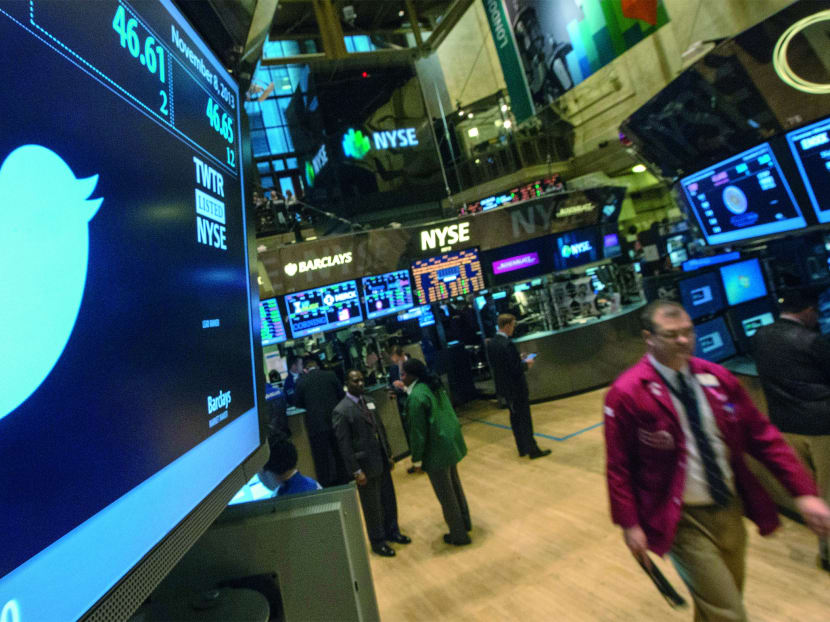Twitter’s fortunes dip further as user-number growth declines
SAN FRANCISCO — Twitter is struggling to convince Wall Street it is still a firm with plenty of potential to grow.

Since Twitter CEO Dick Costolo disclosed in February that user growth had fallen to its lowest in years, the firm’s stock has been trading at 40 per cent below its peak. Photo: Reuters
SAN FRANCISCO — Twitter is struggling to convince Wall Street it is still a firm with plenty of potential to grow.
In its second earnings announcement as a public company, Twitter said on Tuesday that it had more than doubled revenue, beating its forecasts and expectations of investment analysts. However, the social network’s stock fell more than 11 per cent in after-hours trading on sentiment that the number of people who joined it did not rise as fast as many had hoped.
Wall Street, it appears, is more worried about Twitter’s ability to add users and keep them engaged than about its ability to increase revenue.
At its peak last December, Twitter enjoyed a US$46 billion (S$57.8 billion) market capitalisation on only US$665 million of revenue last year, making it one of the world’s priciest stocks.
However, cracks began to show in February, when Twitter Chief Executive Dick Costolo pledged to revive user growth after disclosing that the rate had fallen to its lowest in years. Since then, Twitter’s stock has been trading at 40 per cent below its peak.
On Tuesday, Twitter’s fortunes dipped further south.
“Wall Street is laser-focused on that user number,” said Mr Thomas Forte, an analyst at Telsey Advisory Group in New York. “For Twitter to maximise its value as an investment, it needs to get in front of as many people as possible and do a good job of monetising that audience.”
Twitter said it had 255 million monthly users globally in March, up 5 per cent from 241 million at the end of December. The figure is better than the nine million it added in the last quarter of 2013, when the company grew at 3.8 per cent. But it still represents slowing growth for Twitter and came as investors are increasingly focused on the potential scale of the company’s business.
“It needs to prove that it can be a very large platform,” said Mr Arvind Bhatia, an analyst with US investment firm Sterne Agee. “Can it get to 500, 600 million users worldwide? That’s what it has yet to prove.”
Another area of concern is engagement. On average, users refreshed their Twitter feeds 614 times a month during the recent quarter, up only slightly from 613 times a month in the fourth quarter. Twitter users, especially those overseas, were refreshing their feeds less frequently than they were in the year-ago quarter.
However, most disconcerting for shareholders is that Twitter made US$1.44 in advertising revenue for every 1,000 timeline views, down from US$1.49 in the previous quarter. That may be the best marker of the firm’s ability to make money from its platform and, in the first quarter, it was trending down. In a call with analysts, Twitter’s executives attributed part of that to seasonality as the fourth quarter tends to be the most profitable.
Twitter’s revenue in the first quarter ended March was up 119 per cent to US$250 million (S$314 million) from US$114 million in the first quarter of last year.
Wall Street had expected Twitter to report revenue of US$241 million, according to estimates from Thomson Reuters, while Twitter had forecast slightly lower first-quarter revenue in the range of US$230 million to US$240 million.
Twitter posted a net loss of US$132 million, compared with a loss of US$27 million a year ago. However, adjusted earnings — which exclude stock-based compensation and other expenses — were US$183,000, or about break-even per share, compared with a US$10.5 million loss a year ago.
In an interview, Mr Costolo tried to reassure sceptics. “We’re focused on driving up the value of each timeline,” he said, using a term to refer to users’ Twitter feeds.
He also noted that “favourites” and “retweets” — two actions users take on Twitter’s site that require an extra click — were up 26 per cent in the first quarter and said new users were as engaged as older ones, an indication that the site is not as confusing to newbies as critics contend.
According to market research firm Forrester, only 22 per cent of US adults online visit Twitter at least once a month, lower than Facebook’s 72 per cent. However, in recent months, Twitter has tried to make its platform easier for new users to understand by redesigning its profile pages to resemble those of Facebook and making the integration of photos and videos easier. The firm is also experimenting with a new way to sign up.
Twitter recently made it possible for users to import mobile-phone contacts, so they can follow people they know as they get started. Mr Costolo said users could expect other changes in the second quarter intended to make the platform easier to use.
Twitter has also been courting the television industry as it looks for ways to make money from users. The company said people engaged on Twitter while watching TV shows are more likely to stay tuned during commercials, remember the ads and make purchases, compared with those not on the platform.
Mr Costolo told analysts in the two days after the Oscars that there had been 3.3 billion views of tweets about the show. “There are few other companies with this kind of reach,” he said. “Twitter the platform, we believe, is already incredibly mainstream.”
He added that the Oscars was a “tiny example of the ubiquity, the almost omnipresence, we have in the world to be in front of users”. Agencies





